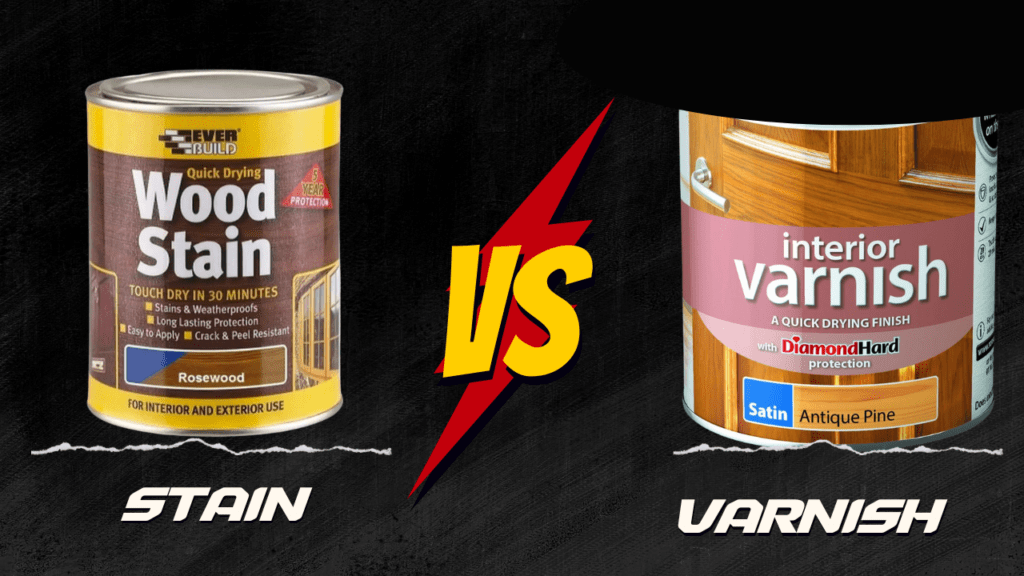
Picking the right finish for your wood project is important—it helps make the wood look good and last longer. Two popular choices are wood stain and varnish, but they are not the same. In this article, we’ll explain how they are different, what they do best, and when to use each one.
What is Wood Stain?
Wood stain is a liquid that changes or improves the color of wood. It comes in many colors and can be light or dark. Stain soaks into the wood and shows off the natural grain, making it look rich and beautiful. It’s a great choice when you want the wood’s natural look to stand out—like in furniture, floors, or cabinets.
Key Features of Stain:
Color Variety: Stains come in many shades, from natural wood tones to bold, non-traditional colors.
Application: Most stains are applied with a brush or cloth and are available in both water-based and oil-based formulas.
Main Purpose: Stains are mainly decorative, focusing on appearance rather than protection. While they do offer some moisture and UV resistance, their primary function is to enhance the wood’s color and grain.
What is Varnish ?
Varnish, on the other hand, is a clear or slightly colored coating that sits on top of the wood and creates a strong, protective layer. It’s made from resin, oil, and a solvent.
When it dries, the solvent goes away, and a shiny, tough film is left behind. Varnish is great for protecting wood from scratches, water, sunlight, and everyday damage.
Key Features of Varnish:
Protection: Varnish provides a strong barrier against physical damage, water, and sun exposure, making it ideal for surfaces that see heavy use or are exposed to the elements.
Finish Options: Available in gloss, satin, and matte finishes, varnish can be chosen to match the desired look of your project.
Application: Varnish is typically applied with a high-quality brush and often requires multiple coats for maximum durability.
Stain vs. Varnish: A Side-by-Side Comparison
| Feature | Stain | Varnish |
| Main Purpose | Enhances color and grain | Provides protection and durability |
| Appearance | Enhances or changes wood color | Clear or slightly tinted, glossy or matte |
| Protection | Minimal (mainly moisture and UV) | High (against scratches, water, and UV) |
| Application | Brush or cloth, water- or oil-based | Brush, water- or oil-based |
| Drying Time | Fast (water-based), slow (oil-based) | Moderate to slow, depends on type |
| Maintenance | May require reapplication for color | Periodic reapplication for protection |
| Best Use | Decorative projects, highlighting wood grain | High-traffic areas, outdoor furniture |
When to Use Stain
Stain is best used when you want to enhance the natural look of the wood without covering it up. It’s ideal for:
Wooden furniture: When you want to bring out the natural grain and color of the wood.
Decking and fencing: To add color while still allowing the wood to breathe.
Interior projects: Where you don’t need a protective layer, but want to improve the appearance of wood surfaces.
Also read:
Wood Finish Basics: A Beginner’s Guide
Water Stains on Wood: 6 Step-by-Step Tricks to remove it
When to Use Varnish
Varnish should be used when you need to protect the wood from damage, moisture, or wear. It’s suitable for:
High-traffic furniture: Such as tables or chairs that see a lot of use.
Outdoor projects: Varnish offers the protection needed for outdoor wood exposed to the elements.
Wooden floors: To shield the wood from foot traffic and heavy use.
Can You Use Stain and Varnish Together?
Yes, stain and varnish are often used together. First, stain is applied to color and enhance the wood, and once it dries, varnish is added to protect and finish the surface. Together, they can create a beautiful and long-lasting wood finish.
How to Apply Stain and Varnish

Step-by-Step Guide to Staining Wood
Prepare the Wood: Sand the surface to remove any imperfections.
Apply Stain: Use a brush or rag to apply the stain in the direction of the grain.
Let it Dry: Allow the stain to soak into the wood and dry thoroughly.
Step-by-Step Guide to Varnishing Wood
Apply a Coat of Varnish: Using a brush, apply a thin layer of varnish over the stained wood.
Let it Dry: Allow each coat to dry before adding another layer. Apply multiple coats for added protection.
Common Mistakes to Avoid
Applying varnish directly to unfinished wood: This can result in an uneven finish.
Over-saturating the wood with stain: This can cause streaks and blotchy areas.
Not sanding between coats: This can leave the finish looking uneven.
Also read:
Wood Wax Finish 101: The Ultimate Guide
Maintenance and Care for Stained and Varnished Surfaces
Proper maintenance is key to keeping stained and varnished surfaces looking their best. Regular cleaning, avoiding harsh chemicals, and touching up any worn areas will extend the life of the finish.
FAQs
1. Can I use varnish over stain?
Yes, varnish can be applied over stained wood to add a protective layer and shine.
2. How long should I wait before applying varnish after staining?
It’s recommended to wait at least 24 hours for the stain to fully dry before applying varnish.
3. Is varnish necessary after staining?
Varnish is not necessary, but it provides valuable protection, especially in high-traffic or outdoor areas.
4. Can I remove varnish from wood?
Yes, varnish can be removed using a paint stripper or sandpaper.
5. Can I mix stain and varnish?
It’s not recommended to mix stain and varnish, but you can use them in succession for the best results.

